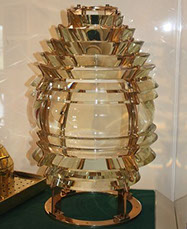 A light station at Point Elliott, the name for this area on navigational charts, was sought by people living in Mukilteo well before the end of the nineteenth century. The effort picked up steam when the shipping industry, along with the Chamber of Commerce in Everett, began to campaign actively for it. By the turn of the century, the project was approved by the United States Lighthouse Board (an agency within the Department of Treasury), and construction began in 1905. Unlike many light stations, all the structures were built of wood, which made sense financially because a large lumber mill was just a few blocks away along the north shore. The danger, of course, was fire, for lighthouses at the time used lanterns in the towers as well as stoves and fireplaces inside the structures. Fortunately, the many fire preventive measures at the light station were effective and no structure ever burned down.
A light station at Point Elliott, the name for this area on navigational charts, was sought by people living in Mukilteo well before the end of the nineteenth century. The effort picked up steam when the shipping industry, along with the Chamber of Commerce in Everett, began to campaign actively for it. By the turn of the century, the project was approved by the United States Lighthouse Board (an agency within the Department of Treasury), and construction began in 1905. Unlike many light stations, all the structures were built of wood, which made sense financially because a large lumber mill was just a few blocks away along the north shore. The danger, of course, was fire, for lighthouses at the time used lanterns in the towers as well as stoves and fireplaces inside the structures. Fortunately, the many fire preventive measures at the light station were effective and no structure ever burned down.
Visitors often wonder why the tower is so short, at a height of only 38 feet. The short answer (no pun intended) is that the height is determined by navigational needs: ships on the open ocean require tall lighthouses that can be seen over the curvature of the earth while lighthouses on lakes and inland waterways, such as Puget Sound, may be shorter due to the shorter distances involved. A shorter lighthouse can actually be more effective because the light is often more visible underneath low clouds and rising fog. The Mukilteo lighthouse was part of a grid of similar light stations throughout Puget Sound that made it possible for every ship to remain within view of at least one light signal. Many people envision lighthouses as crucial beacons warning ships about dangerous shoals, and that popular argument was certainly used around Puget Sound. But the primary and lesser known argument was economic: the leaders of the shipping industry wanted their vessels to remain precisely on the most direct course in order to maximize efficiency.
Visitors often overlook the importance of the fog horn or fog signal. The Mukilteo Light Station started out with a Cunningham eight-foot diaphragm fog horn operated by compressed air. Its giant trumpet protruded from the back wall of the lighthouse. In foggy conditions its deep bass notes could be heard every sixteen seconds up to eight miles away. The original horn was replaced by a more powerful one in the 1970s which was situated closer to the water behind baffling to minimize the noise within Mukilteo. This current horn is activated by a sensor that detects fog within a half-mile and sounds for three seconds every thirty seconds. Older descriptions of light stations often gave as much coverage to the fog signal--whether bells, whistles, or horns--as they did to the nature of the light. But for whatever reasons, the light signal has dominated over time in the popular imagination while the audio element has been relegated into the background. Perhaps, the term “horn station” just could not catch on!
The lighthouse opened officially on March 1, 1906, and continues to operate today, now as a completely automated aid to navigation. The Coast Guard still services the light and some communication equipment, the City of Mukilteo owns everything else, and the Mukilteo Historical Society beautifies the grounds and helps to keep it open for visitors. Though ships today rely more on radar, sonar and global-positioning-system devices, the lighthouse still offers a helpful beacon to all vessels in sight of its glow. It's among the dwindling number of working lighthouses that remain on our nation's coasts.
Copyright 2015, Mukilteo Walking Tour. All rights reserved.